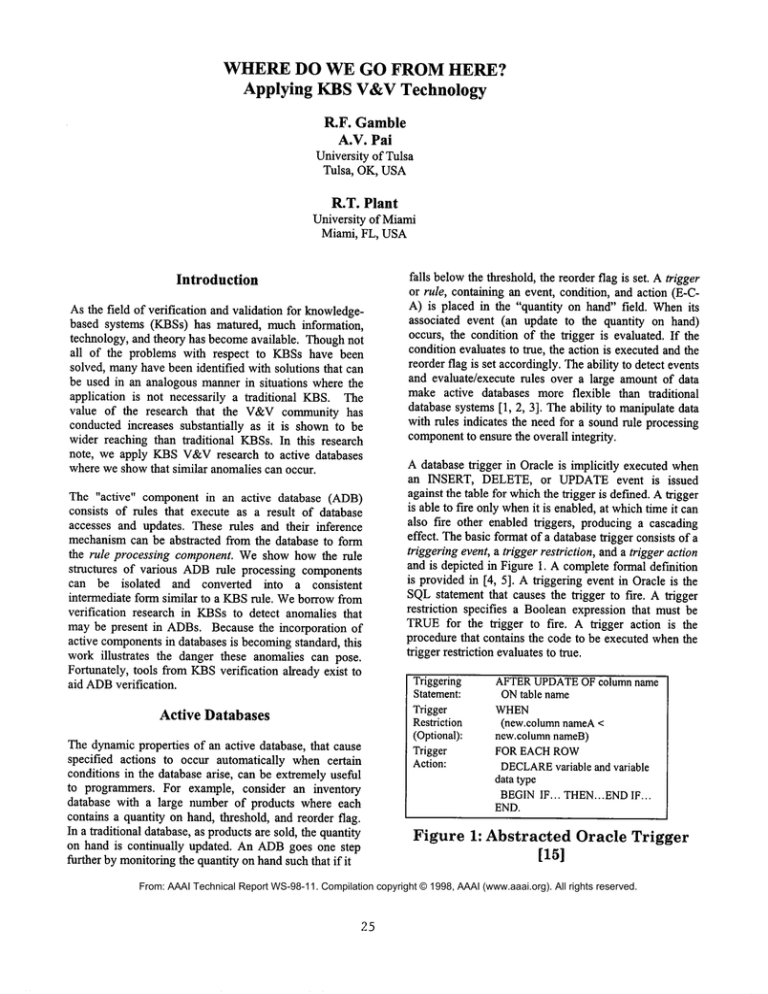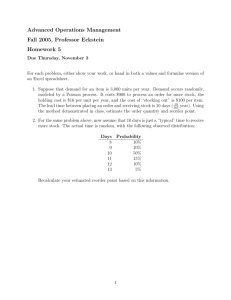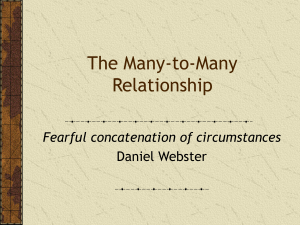
WHERE DO WE GO FROM HERE?
Applying KBS V&VTechnology
R.F. Gamble
A.V. Pai
University of Tulsa
Tulsa, OK, USA
R.T. Plant
University of Miami
Miami, FL, USA
Introduction
As the field of verification and validation for knowledgebased systems (KBSs) has matured, much information,
technology, and theory has becomeavailable. Thoughnot
all of the problems with respect to KBSs have been
solved, manyhave been identified with solutions that can
be used in an analogous mannerin situations where the
application is not necessarily a traditional KBS.The
value of the research that the V&Vcommunity has
conducted increases substantially as it is shownto be
wider reaching than traditional KBSs.In this research
note, we apply KBSV&Vresearch to active databases
where we showthat similar anomalies can occur.
The "active" component in an active database (ADB)
consists of rules that execute as a result of database
accesses and updates. These rules and their inference
mechanismcan be abstracted from the database to form
the rule processing component. Weshow how the rule
structures of various ADBrule processing components
can be isolated and converted into a consistent
intermediate form similar to a KBSrule. Weborrow from
verification research in KBSsto detect anomalies that
may be present in ADBs.Because the incorporation of
active componentsin databases is becomingstandard, this
work illustrates the danger these anomalies can pose.
Fortunately, tools from KBSverification already exist to
aid ADBverification.
Active
Databases
The dynamicproperties of an active database, that cause
specified actions to occur automatically when certain
conditions in the database arise, can be extremely useful
to programmers. For example, consider an inventory
database with a large number of products where each
contains a quantity on hand, threshold, and reorder flag.
In a traditional database, as products are sold, the quantity
on hand is continually updated. An ADBgoes one step
further by monitoringthe quantity on hand such that if it
falls belowthe threshold, the reorder flag is set. A trigger
or rule, containing an event, condition, and action (E-CA) is placed in the "quantity on hand" field. Whenits
associated event (an update to the quantity on hand)
occurs, the condition of the trigger is evaluated. If the
condition evaluates to true, the action is executedand the
reorder flag is set accordingly.Theability to detect events
and evaluate/execute rules over a large amountof data
make active databases more flexible than traditional
database systems [1, 2, 3]. The ability to manipulatedata
with rules indicates the need for a soundrule processing
componentto ensure the overall integrity.
A database trigger in Oracle is implicitly executed when
an INSERT, DELETE, or UPDATEevent is issued
against the table for whichthe trigger is defined. A trigger
is able to fire only whenit is enabled, at whichtime it can
also fire other enabled triggers, producing a cascading
effect. Thebasic format of a database trigger consists of a
triggering event, a trigger restriction, and a trigger action
and is depicted in Figure I. A completeformal definition
is provided in [4, 5]. A triggering event in Oracle is the
SQLstatement that causes the trigger to fire. A trigger
restriction specifies a Boolean expression that must be
TRUEfor the trigger to fire. A trigger action is the
procedure that contains the code to be executed whenthe
trigger restriction evaluatesto true.
Triggering
Statement:
Trigger
Restriction
(Optional):
Trigger
Action:
AFTERUPDATE
OF column name
ONtable name
WHEN
(new.columnnameA
new.columnnameB)
FOR EACH ROW
DECLARE
variable and variable
data type
BEGINIF... THEN...END
IF...
END.
Figure 1: Abstracted Oracle Trigger
[151
From: AAAI Technical Report WS-98-11. Compilation copyright © 1998, AAAI (www.aaai.org). All rights reserved.
25
As many as twelve triggers can be associated with a
single table. Multiple triggers can be fired. Conflict
resolution strategies
have been defmed to manage
multipletrigger firings [5].
KBSVerification and Validation
Applications
Potential KBSAnomalies
KBSverification includes examining the structure and
semantics of a knowledgebase. Primary verification tools
generally analyze the knowledge base for anomalies,
which maybe logical, epistemological, or semantic, and
often fall into the followingcategories [6, 7]: redundancy,
conflicting rules, circularity, and errors of omission.
These categories of anomalies and methods of their
detection have already been widely researched for various
types of K.BSs, including role-based and hybrid (objectoriented and rule-based) systems [6, 8, 9, 10, 11, 13,
14,15, 16].
Structural Similarities with ADBs
The logical form of a knowledge-based system rule and
an active database rule are somewhatsimilar. However,
the rule processing within ADBsdiffers from the rule
processing in KBSs.A KBStypically uses a match-selectexecute cycle in which the knowledge base holds the
rules, the working memoryholds the available facts, and
the inference engine deduces new information by
comparing the contents of working memoryto the rules
and executing some subset of matching rules. An ADB,
on the other hand, uses coupling modeinformation that
indicates whenthe conditions and actions of rules are to
be evaluated and executed relative to a database event.
In order to analyze the ADB
rules such that verification is
facilitated,
we must transform them to a consistent
generic representation as follows:
Rule 5
CREATETRIGGERrchainl
AFTERUPDATEOF quantity
ON inv
FOR EACH ROW
WHEN(((new.QUANTITY
old.DEFECTED_QTY) <=
old.THRESHOLD)
AND(old.status
’UNPREPARED’))
BEGIN
UPDATEstock
SETstatus = ’MIN’
WHERE
itemNo = :old.itemNo;
END
we identify the Event, Condition and Action (E-C-A)
parts as:
Event: UPDATE
OF quantity ONinv
Condition: ((new.QUANTITYold.DEFECTED_QTY) <=
old.THRESHOLD)
AND(old.status
’UNPREPARED’)
Action: UPDATE
stock SET status = ’MIN’
WHERE
itemNo = :old.itemNo;
Theseparts are converted into predicates and represented
in a generic E-C-A format where E1 and E7 represent
events.
Event: E1
Condition: P(x, y, z) ANDQ(w)
Action: E7 ANDT(v)
The next transformation
Condition-Action format.
is to a knowledge base
Condition: E1 ANDP(x, y, z) ANDQ(w)
Action: E7 ANDT(v)
Giventhe Oracle rule:
The intermediate representation given above serves as a
generic language in which to convert different ADB
representations of rules into a consistent format for
analysis. By abstracting awaythe particular syntax of an
ADBrule set we can efficiently
isolate potential
anomalies.
26
Identifying Potential ADBRule Anomalies
In this section, we briefly show how the generic
representation allows for direct anomalydetection using
KBSverification techniques. For example, one method
involves the construction of an event dependencytree. In
order to illustrate potential anomalies,a rule set in Oracle
7 ADBrule syntax was created that contains anomalies
for redundancy, incompleteness, and inconsistency [12].
The portion of the Oracle and KBSrule sets that contain
redundanciesare described in Table 1.
ORACLE ADB RULE SET
KBS RULE SET
RULE1 CREATETRIGGERrulel
RI: E1,P(x,y,z), Q(w)--+
AFTERUPDATE
OF quantity ON inv
FOR EACH ROW WHEN
(((new.QUANTITY - old.DEFECTED QTY) <= old.THRESHOLD)
AND(old.status = ’UNPREPARED’))
BEGINreorder(:old.itemNo); END;
RULE2 CREATETRIGGERsubsumption
R2: E1,P(x,y,z),Q(w),R(v)
AFTERUPDATE
OF quantity ONinv
FOR EACH ROW WHEN
(((new.QUANTITY- old.DEFECTED_QTY)<= old.THRESHOLD)
AND(old.status = ’UNPREPARED’)
AND(old.ONRECALL_LIST= ’TRUE’))
BEGINreorder(:old.itemNo); END,
RULE3 CREATETRIGGERduplication
AFTERUPDATE
OF quantity ONinv
FOR EACH ROW WHEN
(((new.QUANTITY- old.DEFECTED_QTY)
<= old.THRESHOLD)
AND(old.status = ’UNPREPARED’))
BEGINreorder(:old.itemNo), END;
R3: E1,P(x,y,z), Q(w)
RULE4 CREATETRIGGERunnec if
R4: E1,P(x,y,z), ~Q(w)
AFTERUPDATE
OF quantity ON inv
FOR EACH ROW WHEN
(((new.QUANTITY - old.DEFECTED QTY) <= old.THRESHOLD)
AND(old.status = ’PREPARED’))
BEGINreorder(:old.itemNo); END;
RULE5 CREATETRIGGERrchain 1
AFTERUPDATE
OF quantity ONinv
FOR EACH ROW WHEN
(((new.QUANTITY- old.DEFECTED_QTY)<= old.THRESHOLD)
AND(old.status = ’UNPREPARED’))
BEGIN
UPDATEstock
SETstatus = ’MIN’
WHERE
itemNo = :old.itemNo;
END;
R5: EI,P(x,y,z), Q(w)---> E7,
RULE6 CREATETRIGGERrchain2
AFTERUPDATE
OF status ON stock
FOR EACHROWWHEN(new.status = ’MIN’)
BEGINreorder(:old.itemNo); END,
R6: E7,T(x),S(y)--->
Table 1: An Example Rule Set
27
The different types of redundancy can be better seen
when the KBS rules are grouped together in their
redundant configurations as in Table 2. The results of
actually testing the Oracle rules are described in the last
Redundancy Type
Rule Groups
Subsumption
RI: E1,P(x,y,z),
Reduceable
Duplication
Indirect
column. As the reader can see, there are no built-in
database safeguards for the anomalies already knownto
V&Vcommunity.
Result
Both rules execute
Q(w)
R2: E1,P(x,y,z), Q(w), R(v)
The qty_reorder attribute of the On_Reorder
table updated twice
RI: E1,P(x,y,z), Q(w)--~
Both rules execute
R4: E1,P(x,y,z),
The qtyreorder attribute
table updated twice
~Q(w)
of the On_Reorder
RI: E1,P(x,y,z), Q(w)--~
Both rules execute
R3: E1,P(x,y,z), Q(w)
The qty reorder attribute of the On_Reorder
table updated for all attributes regardless of
the restricting conditions on the status of the
Inv table
RI: E1,P(x,y,z), Q(w)-~
All three rules execute
R5: E1,P(x,y,z), Q(w)~ E7,
The qty_reorder attribute of the On_Reorder
table updated twice.
R6: E7,T(x),S(y)
Table 2: Anomaly Rule Groups
While a simple event dependency graph can isolate
redundancy anomalies, further analysis of the rules is
usually required prior to confirming a problem. For
example, if the rule R0, shownin Figure 2, were a part of
the rule set in Table 1, it wouldbe seen as potentially
redundant with respect to events E1 and E2. However,
upon comparing this rule with the other rules that are
triggered by E1 and reach E2, it is concludedthat this rule
is not redundant with the others since the LHSsof R0 and
the other rules leading to event E2 are not problematic.
5. Conclusion
KBSverification and validation techniques have greatly
matured to the point where they can be applied to
analogous types of computation in different domains. We
have shown that these techniques are valuable for
detecting anomalies within the rule processing component
of active databases, where no safeguards against such
anomalies were considered as part of including an
"active" componentin a database.
References
RULE 0
CREATETRIGGERnotRedundant
AFTERUPDATEOF quantity
ON inv
FOR EACH ROW
WHEN
(new.ItemNo = ’ 10A’)
BEGINreorder(:old.itemNo);
END;
1. Hanson, E.N. (1991), The Design and Implementation
of the Ariel Active Database Rule System, Technical
Report UF-CIS-018-92, Department of Computer and
InformationSciences, University of Florida.
2. Stonebraker, M., Hanson,E., and Potaminos.S. (1988),
The POSTGRES
Rule Manager, IEEE Transactions on
Software Engineering, 14(7):897-907.
Figure 2: Rule illustrating additional
analysis after anomalydetection
28
3. Dayal, U. (1988), Active Database Management
Systems, Proc. of Conf. of Data and Knowledge Bases.
Jerusalem.
4. Hanson, E.N., and Widom.J.(1993), Rule processing
active database systems, International Journal of Expert
Systems, 6(1):83-119.
5. Oracle (1992), Oracle Corporation, RedwoodShores,
CA94065. Oracle 7 Server Manuals, Release 7.1.
6. Gamble, R.F. and Shaft T.M. (1996), Eliminating
Redundancy,inconsistency, and incompleteness in rolebased systems, International
Journal of Software
Engineering and KnowledgeEngineering, Vol. 7, No. 4.
7. Murrell, S., and Plant, R.T. (1995), Decision Tables:
Formalisation, Validation and Verification, The Journal
of Software Testing, Verification and Reliability, Vol 5,
(107-132).
8. Murrell, S. and Plant, R.T. (1997), A Survey of Tools
for the Verification and Validation of KBS: 1985-95,
Decision Support Systems, 21:4.
9. Plant, R.T. (1994), Validation and Verification
Knowledge-Based Systems. Workshop Notes AAAI.
1994, Seattle, WA.
10. Gamble, R. and Landauer, C. (1995), Validation and
Verification of Knowledge-Based Systems. Workshop
Notes IJCAI-95, Montreal, Quebec. Canada.
I 1. Mukherjee, R., Gamble, R.F., and Parkinson. J.A.,
(1997), Classifying and Detecting Anomalies in Hybrid
Knowledge Based Systems, Decision Support Systems,
21:4.
12. Pai, A.V. (1995), Verifying the rule processing
components of active databases, M.S. Thesis, Dept. of
Mathematical and Computer Sciences, University of
Tulsa.
13. O’Leary. D.E. (1989), Verification of frame and
semantic network knowledge bases, AAAI-89 Workshop
on KnowledgeAcquisition for KBSs.
14. Preece,A.D., Shinghal, R., and Batarek, A. (1992),
Verifying expert systems: A logical framework and
practical tool, Expert Systems with Applications, 5:421436.
15. O’Keefe, R. and O’Leary, D.E. (1993), Expert system
verification and validation: A survey and tutorial,
Artificial Intelligence Review,7:3 - 42.
29
16. Schmolze,J. and Vermesan,A. (1996), Validation and
Verification of Knowledge-Based Systems. Workshop
Notes AAAI-96,Portland, OR.



